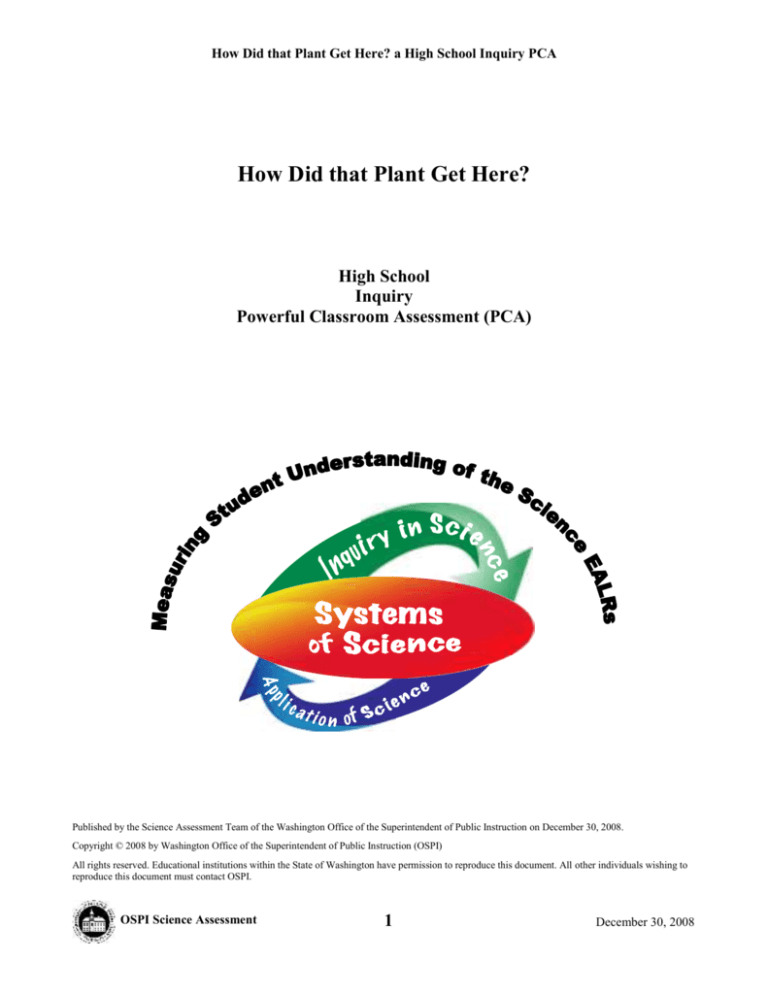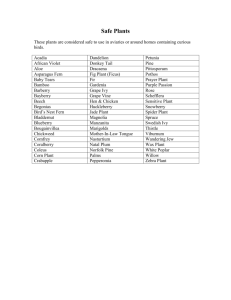
How Did that Plant Get Here? a High School Inquiry PCA
How Did that Plant Get Here?
High School
Inquiry
Powerful Classroom Assessment (PCA)
Published by the Science Assessment Team of the Washington Office of the Superintendent of Public Instruction on December 30, 2008.
Copyright © 2008 by Washington Office of the Superintendent of Public Instruction (OSPI)
All rights reserved. Educational institutions within the State of Washington have permission to reproduce this document. All other individuals wishing to
reproduce this document must contact OSPI.
OSPI Science Assessment
1
December 30, 2008
How Did that Plant Get Here? a High School Inquiry PCA
How Did that Plant Get Here?
Directions: Use the following information to answer questions 1 through 12.
Demetri did the following investigation in a local college laboratory to see how carbon dioxide (CO2) affects
plant growth.
Demetri grew bean plants in growth chambers where he could control the amount of oxygen (O2) and CO2 in the
air around the plants. He grew the bean plants in water with mineral nutrients instead of soil. Demetri had to
completely dry the plants in an oven to get the plants’ dry mass.
Question: What is the effect of different amounts of carbon dioxide (CO2) in air on the dry mass of bean plants?
Hypothesis: As the concentration of CO2 in air increases, the dry mass of bean plants will increase because
bean plants use CO2 for growth.
Materials:
bean plants with the same mass
water with mineral nutrients
identical growth chambers labeled A, B, and C
containers of CO2 and O2 gas
monitors for CO2 and O2 gas
oven
balance
OSPI Science Assessment
2
December 30, 2008
How Did that Plant Get Here? a High School Inquiry PCA
Procedure:
1. Put 12 bean plants into Chamber A as shown in the Investigation Setup diagram. Do the same to
Chambers B and C.
2. Make sure each chamber receives the same amount of light and water. Keep the chambers at a
constant temperature and pressure.
3. Adjust the O2 level of the air in each chamber to the normal amount of O2 in the atmosphere.
4. Remove 4 bean plants from each chamber. Dry the plants in the oven and measure their
dry masses.
5. Calculate and record the average dry masses as Day 1.
6. Set and keep the CO2 level in Chamber A at 0 parts per million (ppm), Chamber B at 700 ppm,
and Chamber C at 1,400 ppm.
7. Repeat steps 4 and 5 for Day 7 and Day 14.
Data:
Amount of CO2 vs. Bean Plant Dry Mass
Amount of CO2
(parts per million)
0
(Chamber A)
700
(Chamber B)
1,400
(Chamber C)
Bean Plant Dry Mass
(averages in grams)
Day 1
Day 7
Day 14
0.8
0.8
0.8
0.8
4.5
8.6
0.8
4.7
10.8
Note: Day 1 masses were determined before CO2 levels were adjusted.
OSPI Science Assessment
3
December 30, 2008
How Did that Plant Get Here? a High School Inquiry PCA
1 Which two variables were controlled variables in this investigation?
o
o
o
o
A. Final bean plant dry mass and amount of light
B. Amount of CO2 and type of growth chamber
C. Growth of plants and amount of O2
D. Type of plants and amount of O2
2 Which variable was the manipulated variable in this investigation?
o
o
o
o
A. Carbon dioxide concentration in each chamber
B. Type of mineral nutrients added to the water
C. Size of bean plants after 14 days
D. Volume of oxygen gas containers
3 Which variable was the responding (dependent) variable in this investigation?
o
o
o
o
A. Hours of light
B. Bean plant dry mass
C. Total days bean plants grew
D. Mineral nutrients in the water
OSPI Science Assessment
4
December 30, 2008
How Did that Plant Get Here? a High School Inquiry PCA
4 Write a conclusion for this investigation.
In your conclusion, be sure to:
Answer the investigative question.
Include supporting data from the Amount of CO2 vs. Bean Plant Dry Mass table.
Explain how these data support your conclusion.
Question: What is the effect of different amounts of carbon dioxide (CO2) in air on the dry mass
of bean plants?
OSPI Science Assessment
5
December 30, 2008
How Did that Plant Get Here? a High School Inquiry PCA
5 Why did Demetri have growth chamber A adjusted to 0 ppm of CO2?
o
o
o
o
A. To show bean plants can make their own CO2 when none is available
B. To make the bean plants use oxygen for photosynthesis instead of CO2
C. To ensure the amount of CO2 caused the differences in dry mass
D. To demonstrate that CO2 is used by the bean plants for respiration
6 Demetri wants to increase the CO2 level from 1,400 ppm to 2,800 ppm and measure the effect on the dry
mass of the bean plants. Which of the following predictions is supported by the Amount of CO2 vs. Bean
Plant Dry Mass table?
o
o
o
o
A. The dry mass would be constant because O2 levels limit the rate of photosynthesis.
B. The dry mass would rise slightly because the rate of photosynthesis limits growth.
C. The dry mass would double because CO2 levels determine the rate of photosynthesis.
D. The dry mass would decrease because high CO2 levels are harmful to plants.
OSPI Science Assessment
6
December 30, 2008
How Did that Plant Get Here? a High School Inquiry PCA
7
Describe two energy transfers that happened in the diagram in the box.
In your description, be sure to:
Identify the forms of energy before and after each energy transfer.
Describe where each energy transfer happened.
You may use words, labeled pictures, and/or labeled diagrams on the diagram below.
One transfer:
Another transfer:
OSPI Science Assessment
7
December 30, 2008
How Did that Plant Get Here? a High School Inquiry PCA
8
Mineral nutrients were added to the water in which the bean plants were grown. What is one reason plants
need mineral nutrients?
o
o
o
o
A. Plants need mineral nutrients to eliminate energy.
B. Plants use the mineral nutrients as a source of energy.
C. Plants use the mineral nutrients in the process of making food.
D. Plants need mineral nutrients to take the place of carbon dioxide.
9 The seeds produced by a bean plant contain proteins. How does the plant obtain these proteins?
o
o
o
o
A. The plant changes heat energy into proteins.
B. The proteins are taken in through the leaves of the plant.
C. The plant makes the proteins using the instructions in DNA.
D. The proteins are absorbed from the soil by the roots of the plant.
OSPI Science Assessment
8
December 30, 2008
How Did that Plant Get Here? a High School Inquiry PCA
10 The genetic material of each bean plant is slightly different from every other bean plant. What causes each
plant to have unique genetic material?
o
o
o
o
A. Each bean seed sprouts into more than one mature plant.
B. Each bean plant develops from the genes of a single parent plant.
C. Each bean seed obtains different resources from the surrounding plants.
D. Each bean plant results from a combination of genes from two parent plants.
11 Why did the dry mass of the bean plants in the investigation increase only in the presence of
carbon dioxide gas?
o
o
o
o
A. Carbon dioxide gas is a source of matter for plant growth.
B. Carbon dioxide gas builds up inside the cells of the plant.
C. Carbon dioxide gas is used in respiration by the plant.
D. Carbon dioxide gas provides energy for the plant.
OSPI Science Assessment
9
December 30, 2008
How Did that Plant Get Here? a High School Inquiry PCA
12 Plan a new investigation to answer the new question printed in the box.
In your plan, be sure to include:
Hypothesis
Materials
Procedure that includes:
logical steps to do the investigation
two controlled variables
one manipulated variable
one responding variable
how often measurements should be taken and recorded
Question: What is the effect of different amounts of mineral nutrients on the height of bean plants
grown in CO2 rich atmosphere?
Hypothesis:
Materials:
Procedure: You may use this space for a labeled diagram to support your procedure.
OSPI Science Assessment
10
December 30, 2008
How Did that Plant Get Here? a High School Inquiry PCA
Procedure (continued):
OSPI Science Assessment
11
December 30, 2008








